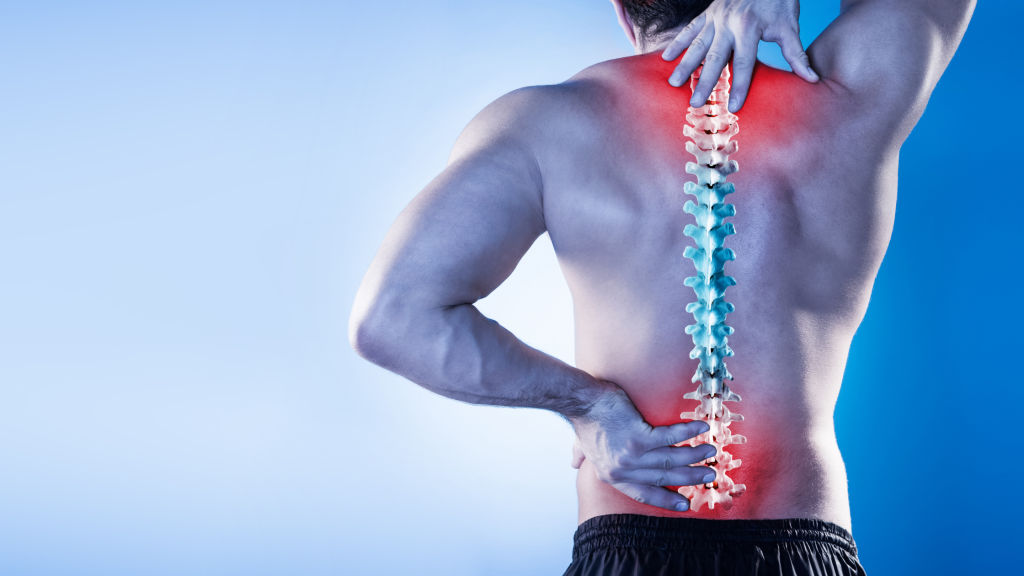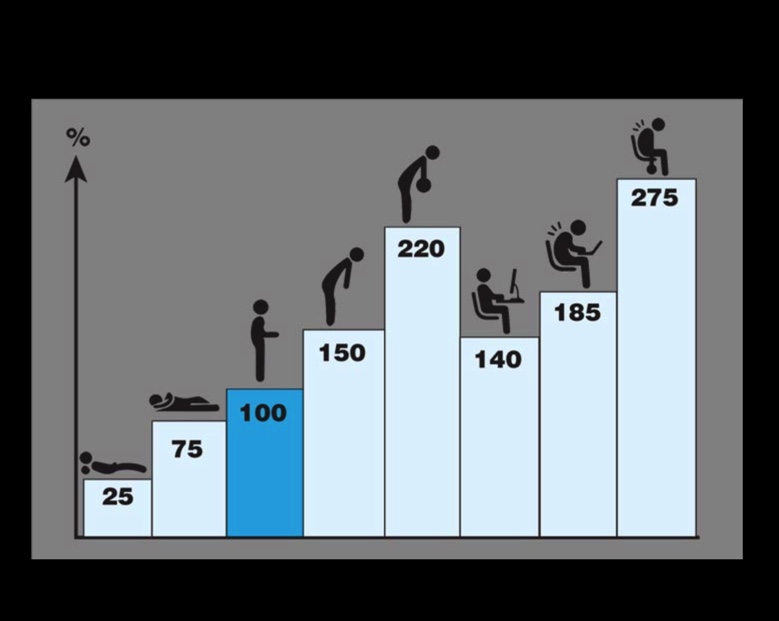
Intervertebral discs are cushions between the bones of the spine. Keeping them healthy is important because they are the spine’s shock absorbers.
An unhealthy or overstrained disc could result in a disc bulge, disc herniation, or eventually degenerative disc disease!
But whilst we’re all busy focussing on eating kefir, kimchi, and drinking probiotic shots for our gut health, and running on the treadmill for our cardiovascular health, we often neglect one of the most important aspect in our whole body – spinal health!
Our posture, body positions, and movements all affect the intervertebral discs, some worse than others.
Take a look at the chart below

Looking at the chart, you can see that the lowest disc pressure is measured while lying flat on your back (25 kg of pressure.)
That’s why when we wake up in the morning, our intervertebral discs are all plumped up because life’s load has been taken off them and restoring them to a nice cushion again.
But lying down all day isn’t practical, and if we did just lay all day, we wouldn’t build strength and resilience in the back to support the loads that our daily grind puts us under (so nice try if you were thinking you should just go back to bed!).
The next load increases when you lay on your side – think sleeping, reading a book on the beach, resting or side-laying exercises like the clam that so many medics prescribe people for their back, hip and knee pain. But again, how often are you lying down on your side in your daily life?
The pressure of the spinal discs increases four times that of laying on your back when you’re standing up straight. Normal standing upright. Life requires us to be upright, and anyone who’s been to a gallery, will appreciate that you can often find your back aching after a long day standing in one upright mode, admiring the art, ‘gallery back’ they call it. It’s the same for those who’s job is a teacher, hairdresser, barista, surgeon, vet, production worker, London commuter, and Pilates teacher, who can all appreciate the weight on your back from standing upright against the pressure of gravity.
Unfortunately, most of us don’t stand up straight, so most people are looking at loads of 150 kg on their spine from just their everyday normal posture!
Advanced osteoporosis may result in a stooped posture or what is often called a “dowager’s hump” at the top of the spine. This is caused by fractures in the vertebrae that make the spine curve and may result in back pain. But it’s not just the eldery or those with medical conditions that have this stoop.
‘Text neck’ is a big thing that has meant people are now rounded and stooped over from looking down at handheld devices such as mobiles and laptops. Most people these days are slightly leaning forward in their normal posture from tight hips, weak abs and back muscles.
Standing jobs that we mentioned above all tend to have a strong element of bending forward, looking over or down. Imagine the hairdresser looking down at the client’s head, the therapist bending over to do someone’s lashes or facial, the teacher looking down at the work of their pupils.
That’s 150kg added pressure on your spine right there!
Now add in lifting or moving something, like a nurse helping patients, or a vet picking up a dog, or a new mum picking up her child, or the hours we often spend in the garden on a Spring weekend, or lifting weights at the gym – well that load just went up to 220kg! (add in the load from the barbell and weights you may have added in the gym too and you can see the effect of heavy increased spinal load will do to you.)
Now imagine if you will, the scary statistic that office workers spend 75% of their waking hours sitting down! That’s around 7-12 hours a day of 140-185kg extra load going onto your spinal discs, just hoping that they will happily take this extra pressure every day and not grumble!
The highest pressure on the disc of the lumbar spine occurs when you are seated and leaning forward while bearing weight (275 kg of pressure.)
Let’s not panic!
Normal, healthy spines can support these weights. The spine is an incredibly hardy thing.
HOWEVER, you can’t expect to be bending over to lift heavy weights at the gym, sitting down at the desk for a job, having poor posture, doing a lot of commuting or travelling, lifting the kids all day, sitting on the sofa, or gardening for hours… every day, every week, and all year round, and expect your back to take it!
Plus, as we age, the amount of water in their vertebral discs decreases, making them less flexible and more prone to tearing or injury. This is age-related wear and tear, known as disc degeneration.
Gravity has a strong effect on posture. The natural effect of this force is to pull us forward. Inactivity with increased time sitting may be part of the problem. The flexor muscles of the hip can even become shortened from being in a chronically contracted state.
What did we say about your intervertebral discs?
They are the cushions between the bones of the spine. (your vertebrae)
Keeping them healthy is important because they are the spine’s shock absorbers. When your spine is young and healthy, the discs are plump and absorb the impact of life’s hobbies and daily grind. But over time, without the focus of something like Pilates affecting the space in your discs, that load starts to grind down the cushion and cause back, neck, buttock, hip, knee or shoulder pain.
So, how does Pilates help?
Thankfully, we have the most incredible method of exercise created by Joseph Pilates, who put a strong emphasis on strengthening the centre part of the body (the deepest supporting abdominal muscles, back muscles, pelvic area) whilst putting the body through movements that were all designed to bend, twist, extend and stretch the spine and oil the joints!
All of the apparatus Mr. Pilates created either helps an opening, like our much-loved barrels, to help open tightnesses in the hips, chest, back, etc, or the springs he created on things like the Reformer, Tower, Cadillac, Chairs, Foot and Toe Corrector, add resistance like weights in a gym, but cleverly whilst putting them under length at the same time, so you get longer stronger muscles.
Life and gravity compress our spines and joints every day, so cleverly, everything we do in Pilates is designed to create space for the spine, the joints, and the vital organs. That means less time worrying about pain, aches, or injuries and more time to enjoy your life!
